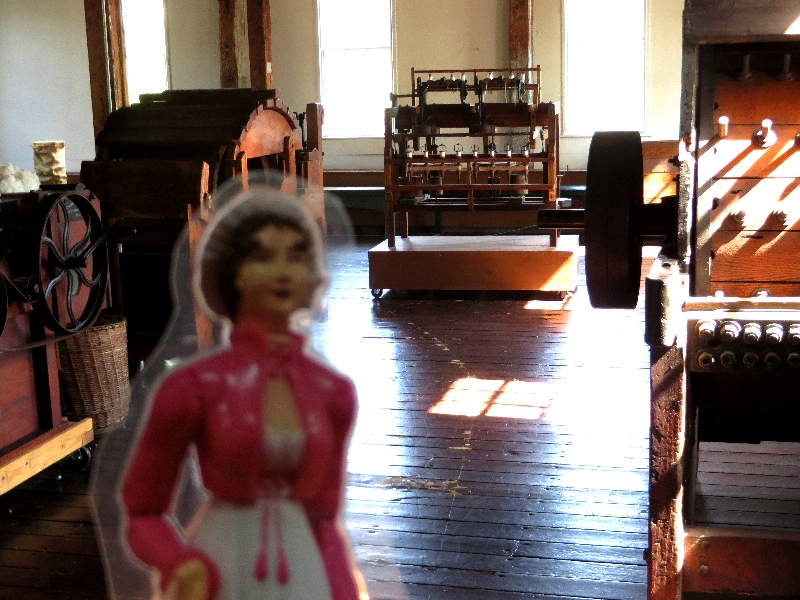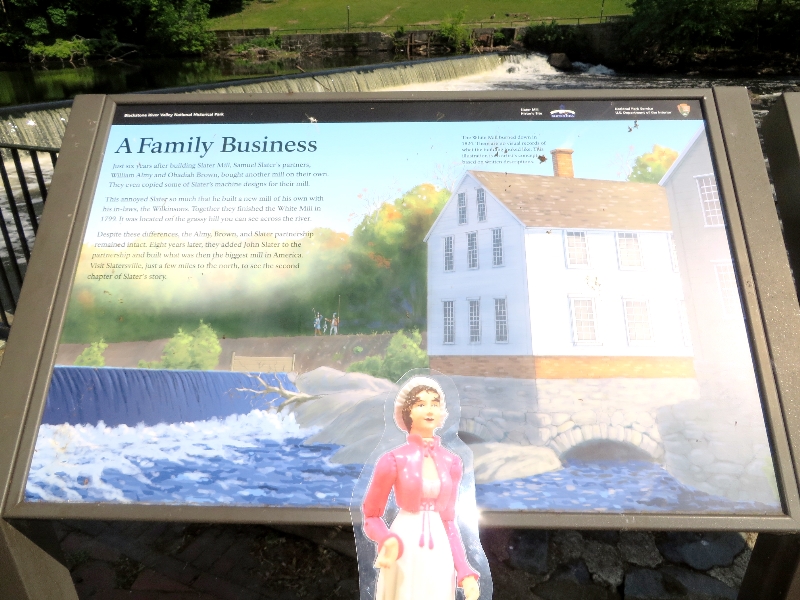Flat Jane Austen in Rhode Island:
In which she learns of a Traitor
and the Industrial Revolution
Mr. Slater first began to work for Mr. Moses Brown at Ezekiel Carpenter's fulling mill, near Mr. Sylvanus Brown's cottage. Mr. Moses Brown wished for Mr. Slater to correctly put together the pieces of old machinery he had acquired from other manufactories. Mr. Slater realized he needed to start fresh. He struggled a bit but with the help of Mr. S. Brown and Mr. David Wilkinson, he built a spinning machine, a carding machine and added a bale breaker.
The experiment was so successful, Mr. M. Brown, his son-in-law William Almy, his son Obidiah Brown, and his cousin, Mr. Smith Brown built Mr. Slater a mill and made him a partner. Mr. Slater hired 9 children from nearby farms and his young brother-in-law, Smith Wilkinson, to operate the machines.
Here in Britain we use children from the workhouse. Those children used water-powered machines to make white cotton (thread) on demand. Mr. Slater was accustomed to making yarn for stockings. This mill is the first successful, modern, water-powered cotton mill in America.
Editor's note: The following history is going to be difficult. Please read at your own risk. Jane's intention is to show you the process of making thread in the early 1800s.
The process begins with cotton. Cotton comes from a plant which grows in warm climates.
Mr. Slater intended to use cotton from the Dutch colony of Surinam in the West Indies to make cloth, however, his late wife, at the time 18 years of age, spun the cotton on a hand spinning wheel resulting in cotton thread stronger than linen. It is said she was the first woman in America to have a patent.
Mr. Slater, however, first turned his attention to cotton twist threads used for the warp (vertical) threads on a hand loom. After success with local weavers producing cloth, Mr. Slater began producing cotton thread earlier this century.
In '93, the same year Almy, Brown and Slater opened for business, an American Yankee, Eli Whitney, invented a machine to separate the seeds from the cotton. The cotton gin makes it much easier to get American grown cotton from the South. All the work of growing the cotton and separating the seeds is done by slaves [enslaved people]. First they use to cotton gin (engine) to remove the seeds, then they beat the cotton over an open work table (willow) to remove any excess dirt.
Finally, the cotton is made into bales. Bales weighing 500 pounds each, are put on a cart piled with many others, shipped to a seaport city, placed on a boat and shipped to Providence. From Providence it arrives up the Seekonk River by boat and unloaded by the mill.
 |
| Jane in Slater Mill with a cotton bale behind her. The cotton gin is in the center and carding machine to the right. |
Mr. Moses Brown was pleased to have a project solely made in America.
When the cotton arrives in the mill, the hands grab the cotton and place it on the bale breaker which fluffs the cotton back up into workable fiber.
 |
| Jane poses in front of the bale breaker. |
Next, the hands took the fluffed cotton to the carding machine to be made into slivers, long flat sheets of smooth cotton. Samuel Slater made particular improvements to this machine.
After carding, the cotton sliver is taken to another machine for a twist. This is called roving. Roving is not yet strong enough to weave into cloth. 'Tis still too loose and breaks easily.
The roving is then taken to a spinning machine such as this Arkwright Water Frame. THIS is the invention Mr. Slater stole and brought to America. He built an American version of a British machine.
 |
| Arkwright Waterframe in the background center. |
The water power turns the spools with the roving, twists the roving again and wraps it around the finished thread bobbins.
Mr. Slater had great success with this machine but it soon became outdated. As Mr. Slater is a traitor to his country, he is not allowed to return and observe new machinery at work. He sent word to his younger brother John to 'prentice to one of the mills and learn this machine. Mr. Samuel Slater begged of young John to come to America with his knowledge. Mr. John Slater, also a traitor, brought knowledge of the Crompton Spinning Mule, the machine which makes thread for muslin! 'Tis not as fine as India mull but is much cheaper.
 |
| The Crompton Spinning Mule, a hybrid of two earlier machines. The first to do spinning and winding on one machine. |
 |
| Another of Mr. Slater's machines. |
The machine Mr. Slater currently uses in his mill is a Throstle, named after the throstle or thrush bird. The early version twisted threads. This machine features a heart-shaped cog at the bottom, an invention of Mr. Slater's. The cog lifts the bobbins up so that the thread may wind more evenly around the bobbins.
Mr. Slater revolutionized the textile industry. He soon opened a new mill across the river with Mr. John Slater. This one runs continuously so that the mill has a ready supply of thread available for the merchants. The thread can be easily shipped out via the river.
He
owns many mills in Rhode Island, Massachusetts, Connecticut and New Hampshire. Recently, following the death of wife Hannah, Mr. Slater removed to farther up the Blackstone Valley to Massachusetts. He still retains shares in this mill and many others. His business prospered during the late hostilities between Britain and America when British goods were not allowed to be imported but now, with the war over, European goods are much more in demand. Mr. Slater's business is not as robust as it once was but he is not yet ruined. Mr. Slater's success is greatly lauded here in America.
Mr. John Slater started a new mill and a new system of
manufacturing wherein he hired families. There, the families live in the village near the mill, all work in the
mills and on Sundays they attend church and Sunday school where the minister
preaches the evils of drink. No saloons or other immoral practices are allowed. (Mr. and Mrs. John Slater are Congregationalists).
Where once field and forest stood and farmers eked out a living are now numerous manufacturing villages. Life is no longer governed by the sun but by the bell. As of today, 1816, there are 140 cotton manufacturers within 30 miles of Providence, employing 26,000 hands and operating 130,000 spindles.
 |
| 1820s bell tower |
There is now talk of building a canal along the Blackstone River to make transport of goods easier.
Editor's note: While the cotton gin was originally designed to make life easier and reduce the dependency on enslaved labor, in actuality, it had the opposite effect on the American economy. It made cotton cheaper and easier to obtain for our northern mills and perpetuated slavery until the end of the Civil War. Many Rhode Island mills were dependent on southern cotton and made cheap cotton cloth for clothing for enslaved people. To learn more, visit the website for the Blackstone Valley National Historic Park.
The Blackstone Canal was built in 1828 and opened to much fanfare, however, it was soon superseded by the railroad as early as 1847.
Please turn the page





No comments:
Post a Comment